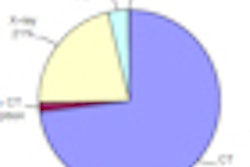A new user analysis of MDCT utilization and sales trends has identified a shift in the balance of market power, which now appears to favor acute care hospitals over private-practice freestanding medical imaging centers.
Based on a survey of 421 imaging managers and chief technologists, the new market research report from IMV Medical Information Division indicates that hospital administrators have a more positive outlook about the future of CT than managers of nonhospital-affiliated freestanding imaging centers.
Hospitals are experiencing increased patient volume per CT scanner, while utilization per CT scanner at facilities that are not affiliated with hospitals is decreasing, noted Lorna Young, senior director of market research at IMV.
"The volumes are definitely lower for freestanding centers than for services owned by hospitals," Young said.
Hospital-owned imaging centers are typically handling at least 20% more CT volume per scanner compared to comparable systems at freestanding centers without hospital ownership. Overall, the average number of CT procedures per hospital is close to 7,900 exams annually, more than double the annual volume for services that are not affiliated with a hospital.
"The outlook for hospital-based CT remains strong, both in terms of their patient referral patterns and efficiency in using the modality," Young said. "Everybody is feeling the pinch of reduced reimbursements, but private-practice freestanding services are feeling the pinch much more severely. Our numbers and the opinions expressed by our survey respondents corroborate that."
The online survey, conducted in March 2011, reported that 12,740 CT scanners are installed at 8,180 hospitals and freestanding medical sites in the U.S. The installed base grew 22% since IMV's last CT report in 2007. The average number of CT scanners per site rose from 1.4 to 1.6 systems per facility.
The installed base total was reported with the understanding that new CT installations plummeted in 2009 and remained depressed in 2010, Young noted. Some growth in the installed base identified by the current survey may reflect more success in identifying the location of CT equipment than in 2007, Young said.
Longer replacement cycles
Imaging facilities are squeezing more life from their CT scanners in response to lower reimbursement. The survey found that imaging services are now typically replacing their CT systems after slightly more than eight years of service, compared with seven years for equipment retired in 2007.
"People are getting a lot more use from what they've got," Young said.
Equipment purchasing trends have shifted in step with the introduction of 64-slice, 128-slice, and even more powerful CT technologies, despite residual interest in 16-slice CT. According to the survey, nearly half (46%) of the sales in the U.S. in 2010 involved 64-slice or more powerful CT scanners. Sixteen-slice CT technology accounted for nearly 40% of the 2010 installations.
Some providers are moving beyond 64-slice technology. Survey results suggest that 25% of future CT sales will involve technology utilizing 128 or more slices.
Stable utilization
The 6% annual growth rate for CT utilization in the U.S. attests to the essential role the modality plays in medicine, according to Young. Some analysts predicted slower growth in light of controversies regarding CT exams and high patient exposure to ionizing radiation and possible future cancer risks. Yet CT use has still grown about twice as fast as the 3% annual growth rate for MRI, Young noted.
The growth in CT utilization was mainly powered by a greater demand for chest, spine, head and neck, and brain imaging since 2007. The procedural totals for bread-and-butter abdominal and pelvic applications were flat.
Declining contrast media use
Though safety concerns did not appear to affect overall utilization, they do seem to have impacted contrast media use. The survey found that 55% of CT procedures performed in 2010 were contrast-enhanced, down from the 67% identified by the 2007 IMV report and older CT surveys conducted by IMV.
"People are very focused on reducing the amount of contrast needed for CT procedures and the potential of allergic reaction to contrast," Young said. "From their responses to our open-ended questions, it appears that they are trying to reduce the instances when they use contrast media, as well as how much contrast is used when it is needed."
Disclosure notice: AuntMinnie.com is owned by IMV, Ltd.




















